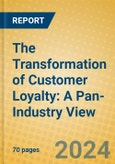In a time of uncertainty, brands must ensure that the value proposition provided by their loyalty schemes is firmly aligned with customer needs, priorities and expectations, continuously refined and adapted to withstand disruption and changing market conditions. This report explores how loyalty programmes are evolving across key industries worldwide.
The Transformation of Customer Loyalty: A Pan-Industry View global briefing offers an insight into the size and shape of the luxury goods industry, highlights buzz topics, emerging trends as well as pressing industry issues, their effects on luxury goods retailing in markets around the world and on the development of consumers’ shopping patterns. Forecasts illustrate how the market is set to change and criteria for success. In short, it identifies the opportunity zones within luxury goods industry
Product coverage: Experiential Luxury, Fine Wines/Champagne and Spirits, Personal Luxury, Premium and Luxury Cars.
Data coverage: Market sizes (historic and forecasts), company shares, brand shares and distribution data.
Key Findings
Lifestyle loyalty schemes
Creating lifestyle loyalty programmes has become an essential focus for brands across different industries by rewarding actions rather than purchases. They aim to become part of the everyday lives of their consumers, incentivising wellness and wellbeing behaviours, delivering utility as well as innovative but highly personalised benefits. By forming relevant partnerships and delivering more choices for members with the help of these schemes, brands are able to stand out from the crowd and remain relevant.
Elevating value proposition vital more than ever
As consumers become savvier, they seek to gain more added value from their regular purchases and from their membership participation. This is forcing brands to adapt and deliver wide-ranging rewards offerings, more prestigious membership status, enjoyable experiences, and personalised services.
Communities and co-creation in huge demand
Building a brand community as part of the loyalty programmes is imperative for deepening the customer engagement, supporting peer-to-peer interaction and social impact initiatives, creating more lasting relationships with members and ultimately accessing vital feedback and information about the brand’s customer base. Brand communities are the perfect platform for product and marketing co-creation with the business, which further entices more innovation as well as loyal and top-spending consumers.
Innovation and technology revive stale legacy structures
In a time of technological disruption and innovation, customer loyalty is changing. Companies are embracing new business models to expand the potential of loyalty schemes, ensure borderless reach and deliver new incentives. With digitalisation extending its reach, using mobile strategies to drive loyalty is essential, and in turn offers a direct connection to the customer.
Why buy this report?
- Get a detailed picture of the Luxury Goods market;
- Pinpoint growth sectors and identify factors driving change;
- Understand the competitive environment, the market’s major players and leading brands;
- Use five-year forecasts to assess how the market is predicted to develop.
Table of Contents
Companies Mentioned (Partial List)
A selection of companies mentioned in this report includes, but is not limited to:
- BeautyCounter
- Bubble
- YSL Beauty
- Liberty
- General Mills
- Kraft Heinz
- Tim Hortons
- Boba Guys
- Taco Bell
- Accor
- ANA Pocket
- The Fresh Market
- Marks & Spencer








